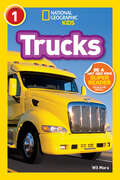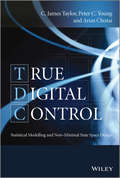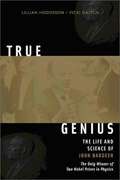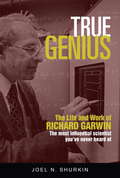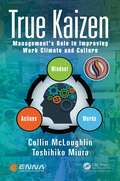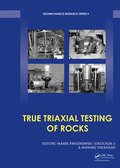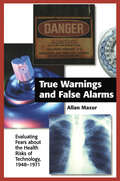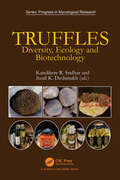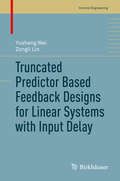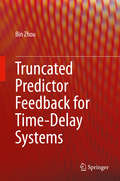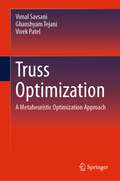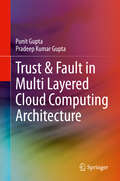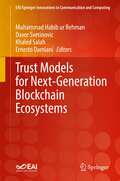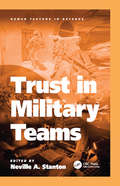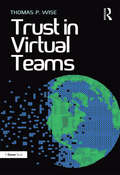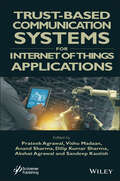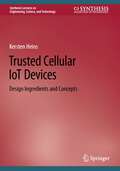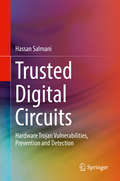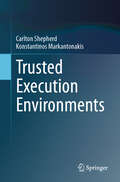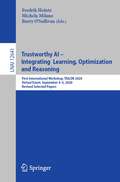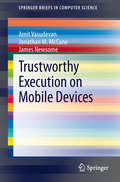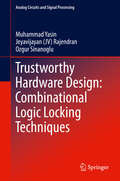- Table View
- List View
Trucks (Readers)
by Wil MaraWho can resist trucks? They&’re loud. They&’re complicated. They have wheels twice as tall as your dad. Trucks! has many cool images of the trucks we know and love. There are also curiosities like the $3 million mining truck that&’s "like driving a house." This level 1 text is revved up with sound words and images to steer young readers on the road to reading success.National Geographic supports K-12 educators with ELA Common Core Resources.Visit www.natgeoed.org/commoncore for more information.
True Bugs (Heteroptera) of the Middle-East
by J. E. McPherson Hassan Ghahari Pierre MouletThis reference guide covers information on the true bugs (Heteroptera) of Middle East and includes taxonomy, general biology, economic importance, applied aspects, and distributional data. It also includes up-to-date reviews of the literature on the Heteroptera of the Middle East. The book represents a clear guide for future research in heteropteran biology. Apart from providing a taxonomic treatment of all the families known from the Middle East, information is provided on Iranian and general geographic distributions, bionomics, ecology, natural enemies, prey records, and plant associations for the various species. General discussion also is included on morphology, economic importance, family characters of each group, and affinity with related groups. This book includes detailed information on more than 2,000 species of the Middle East Heteroptera belonging to 58 families. An exhaustive bibliography (over 4,000) has been provided to facilitate studies of chosen aspects of the various species. Up-to-date information for the various species has been provided as far as possible. The book contains the contributions of 37 heteropteran specialists from 17 countries. This book is of interest to teachers, researchers, and masters and Ph. D students of entomology, biosciences, agriculture, biological control, IPM (Integrated Pest Management), and environmental sciences. Also, the book serves as additional reading material for undergraduate and graduate students of the mentioned scientific fields. National and international entomological and agricultural scientists may also find the book to be a useful read as well as those individuals who are active in medical, urban, and forensic entomology because there are several heteropteran pests in these fields.
True Digital Control: Statistical Modelling and Non-Minimal State Space Design
by C. James Taylor Peter C. Young Arun ChotaiTrue Digital Control: Statistical Modelling and Non–Minimal State Space Designdevelops a true digital control design philosophy that encompasses data–based model identification, through to control algorithm design, robustness evaluation and implementation. With a heritage from both classical and modern control system synthesis, this book is supported by detailed practical examples based on the authors’ research into environmental, mechatronic and robotic systems. Treatment of both statistical modelling and control design under one cover is unusual and highlights the important connections between these disciplines. Starting from the ubiquitous proportional–integral controller, and with essential concepts such as pole assignment introduced using straightforward algebra and block diagrams, this book addresses the needs of those students, researchers and engineers, who would like to advance their knowledge of control theory and practice into the state space domain; and academics who are interested to learn more about non–minimal state variable feedback control systems. Such non–minimal state feedback is utilised as a unifying framework for generalised digital control system design. This approach provides a gentle learning curve, from which potentially difficult topics, such as optimal, stochastic and multivariable control, can be introduced and assimilated in an interesting and straightforward manner. Key features: Covers both system identification and control system design in a unified manner Includes practical design case studies and simulation examples Considers recent research into time–variable and state–dependent parameter modelling and control, essential elements of adaptive and nonlinear control system design, and the delta–operator (the discrete–time equivalent of the differential operator) systems Accompanied by a website hosting MATLAB examples True Digital Control: Statistical Modelling and Non–Minimal State Space Design is a comprehensive and practical guide for students and professionals who wish to further their knowledge in the areas of modern control and system identification.
True Genius: The Life And Science Of John Bardeen
by Lillian Hoddeson Vicki DaitchWhat is genius? Define it. Now think of scientists who embody the concept of genius. Does the name John Bardeen spring to mind? Indeed, have you ever heard of him?Like so much in modern life, immediate name recognition often rests on a cult of personality. We know Einstein, for example, not just for his tremendous contributions to science, but also because he was a character, who loved to mug for the camera. And our continuing fascination with Richard Feynman is not exclusively based on his body of work; it is in large measure tied to his flamboyant nature and offbeat sense of humor.These men, and their outsize personalities, have come to erroneously symbolize the true nature of genius and creativity. We picture them born brilliant, instantly larger than life. But is that an accurate picture of genius? What of others who are equal in stature to these icons of science, but whom history has awarded only a nod because they did not readily engage the public? Could a person qualify as a bona fide genius if he was a regular Joe?The answer may rest in the story of John Bardeen.John Bardeen was the first person to have been awarded two Nobel Prizes in the same field. He shared one with William Shockley and Walter Brattain for the invention of the transistor. But it was the charismatic Shockley who garnered all the attention, primarily for his Hollywood ways and notorious views on race and intelligence.Bardeen’s second Nobel Prize was awarded for the development of a theory of superconductivity, a feat that had eluded the best efforts of leading theorists—including Albert Einstein, Neils Bohr, Werner Heisenberg, and Richard Feynman. Arguably, Bardeen’s work changed the world in more ways than that of any other scientific genius of his time. Yet while every school child knows of Einstein, few people have heard of John Bardeen. Why is this the case?Perhaps because Bardeen differs radically from the popular stereotype of genius. He was a modest, mumbling Midwesterner, an ordinary person who worked hard and had a knack for physics and mathematics. He liked to picnic with his family, collaborate quietly with colleagues, or play a round of golf. None of that was newsworthy, so the media, and consequently the public, ignored him.John Bardeen simply fits a new profile of genius. Through an exploration of his science as well as his life, a fresh and thoroughly engaging portrait of genius and the nature of creativity emerges. This perspective will have readers looking anew at what it truly means to be a genius.
True Genius: The Life and Work of Richard Garwin, the Most Influential Scientist You've Never Heard of
by Joel ShurkinRichard Garwin was awarded the Presidential Medal of Freedom by President Barack Obama Called a "true genius" by Enrico Fermi, Richard Garwin has influenced modern life in far-reaching ways, yet he is hardly known outside the physics community. This is the first biography of one of America's great minds--a top physicist, a brilliant technological innovator, and a trusted advisor of presidents for sixty years. Among his many contributions to modern technology are innovations we now take for granted: air-traffic control systems, touch screens, color monitors, laser printers, GPS satellite navigation, and many other facets of everyday contemporary life.But certainly his most important work has been on behalf of nuclear disarmament. As a key member of the Los Alamos team that developed the hydrogen bomb (he created the final design), Garwin subsequently devoted much of his career to ensuring that nuclear weapons never again be used. He has spent hundreds of hours testifying before Congress, serving on government advisory committees, and doing work that is still classified, all the while working for IBM as a researcher. A genuine polymath, his ideas extend from propulsion systems for interplanetary flight to preventing flu epidemics. Never shy about offering his opinions, even to rigid government bureaucracies unwilling to change, Garwin continues to show leaders how to do the smart thing. The world is a more interesting and safer place because of his many accomplishments.
True Kaizen: Management's Role in Improving Work Climate and Culture
by Collin McLoughlin Toshihiko MiuraWhat does it take to manage an organization to success? No matter what industry you are in, an organization is primarily a group of people. This book focuses on that ever-important human element. In the rush to get 'lean', many organizations focus solely on tools for increasing productivity, but where do these tools come from? In this book, Collin McLoughlin and Toshihiko Miura look back on their decades of international consulting experience to examine how organizations around the world have transformed on a cultural level by respecting the people who work within them and leveraging their creativity to solve problems. As our workforce becomes more knowledgeable, skillful, and more perceptive of their needs and wants as employees, the ability to reach the true potential of an organization becomes more and more difficult. Managers must look at each individual element of an equation like this in order to fully understand how to achieve an answer. They must begin to answer more focused questions, such as: 1. How productive is the existing work climate and culture? 2. How do employees, as individuals, navigate the existing work climate? (How do they deal with day-today issues with each other?) 3. Where and how are individuals and their work processes assessed? 4. What obstacles do employees face every day, and are they empowered to fix these obstacles? 5. What role does leadership play at each level of the organization? (Looking at the organization in layers of management.) To address these challenges, this book focuses on three main aspects of leadership and management: 1. Addressing and Improving the Perspective of Management -- The ideas presented in this book are not limited to a certain industry or field of work, but can be applied in any setting because they speak to a universal human element. 2. Exploring and Improving Work Climate -- Organizations are social entities, operating within their own controlled environment. This book will explore the factors that contribute to, and encourage, a positive work climate. 3. Observing and Eliminating Wasteful Work Processes -- Observing wasteful activities and work processes requires a refined perspective. The case studies presented illustrate the How and Why to help refine expertise. This will also lead to the joy and benefits
True Triaxial Testing of Rocks (Geomechanics Research Series #4)
by Xiaochun Li Marek Kwaśniewski Manabu TakahashiThe book provides a guide to rock engineers and engineering geologists as to how to perform laboratory tests and how to use the existing data for solving practical rock engineering design and operating problems. Knowledge of the behavior of rocks under general triaxial compression is also of crucial importance in the fields of structural geology and tectonophysics as the effect of the intermediate and the minimum principal stresses may be a decisive factor in the mode of deformation and processes of gross-fracturing, faulting and earthquakes.
True Warnings and False Alarms: "Evaluating Fears about the Health Risks of Technology, 1948-1971"
by Allan MazurGiven time, scientists reach consensus about the truth or falsity of a wide range of alleged hazards. Today, there is broad agreement that CFCs destroy stratospheric ozone. On the other hand, research does not support claims that electromagnetic fields from transmission lines cause a noticeable increase of leukemia. But new allegations continuously arise. Are manufactured chemicals in the environment distorting normal hormonal processes in our bodies? Are genetically modified foods a cause for concern? Addressing one of the most vexing problems in risk policy, Allan Mazur asks how we can tell, at an early stage, how seriously we should take a new warning. To identify hallmarks that could help predict the truth or falsity of an alleged hazard, Mazur analyzes 31 health warnings raised during the 1950s and 1960s about diverse technologies, including fluoridation, DDT, cyclamate, nuclear weapons testing, and birth control pills. Among his considerations are the initial source of an alarm, the biases held by its primary 'sponsors,' and the type of media coverage it receives. With 30 to 50 years of hindsight, he identifies characteristics - apparent from the outset of a controversy - that most effectively distinguish true warnings from false alarms. Early recognition and a timely response to a genuine hazard are important to protect our environment, health, and economic well-being. But if we act quickly and a warning turns out to be false, money is wasted, people are needlessly frightened, regulators lose credibility, and our ability to appropriately handle the next set of risks is compromised. Mazur's findings do not provide certainty about which of today's warnings will prove true and which will prove false. But they do help us to make informed judgments about where it is best and most reasonable to direct our worries and resources.
Truffles: Diversity, Ecology and Biotechnology (Progress in Mycological Research)
by Sunil K. Deshmukh Kandikere R. SridharTruffles are hypogeous ectomycorrhizal ascomycetous edible mushrooms distributed worldwide in terrestrial ecosystems, including deserts, as non-timber forest products. They are seasonal and have a short shelf life. Owing to their nutraceutical value, truffles are in high demand and valuable. Of the 180 or more species of truffles reported worldwide, only around 20 are commercially viable. Truffles: Diversity, Ecology and Biotechnology reviews the current advances in truffles from a historical perspective and covers ethnomycological profiles, habitats, ecology, geographical distribution, diversity, systematics, phylogeny, ultrastructure, sexual reproduction, cultivation, analytical techniques, and the impact of climate change and industrial applications on truffles. It also emphasizes the role of soil properties in the occurrence of truffles (e.g., Tuber spp.), their pathogens, product development and marketing. The contributors hail from academia and industries across the globe.
Truncated Predictor Based Feedback Designs for Linear Systems with Input Delay (Control Engineering)
by Zongli Lin Yusheng WeiThis monograph is the first of its kind to present innovative research results on truncated predictor feedback (TPF) designs for general linear systems with input delay. Beginning with a brief review of time delay systems, the first half of the book focuses on TPF with a constant feedback parameter. Both state feedback and output feedback are considered. It is established that TPF achieves stabilization in the presence of an arbitrarily large bounded delay if the open loop system is not exponentially unstable. Examples are presented to illustrate that TPF may fail to stabilize an exponentially unstable system when the delay is sufficiently large. Bounds on the delay are then established under which stabilization can be achieved. The second half of the book explores variations of the TPF laws designed with a non-constant feedback parameter to accommodate unknown delays and improve closed-loop performance. The authors employ a step-by-step approach to presenting the ultimate result on a completely delay-independent feedback law. Truncated Predictor Based Feedback Designs for Linear Systems with Input Delay will appeal to control engineers, control theorists, and graduate students studying control systems. This volume will also be a valuable resource for engineers and applied mathematicians interested in dynamic systems with time delays.
Truncated Predictor Feedback for Time-Delay Systems
by Bin ZhouThis book provides a systematic approach to the design of predictor based controllers for (time-varying) linear systems with either (time-varying) input or state delays. Differently from those traditional predictor based controllers, which are infinite-dimensional static feedback laws and may cause difficulties in their practical implementation, this book develops a truncated predictor feedback (TPF) which involves only finite dimensional static state feedback. Features and topics: A novel approach referred to as truncated predictor feedback for the stabilization of (time-varying) time-delay systems in both the continuous-time setting and the discrete-time setting is built systematically Semi-global and global stabilization problems of linear time-delay systems subject to either magnitude saturation or energy constraints are solved in a systematic manner Both stabilization of a single system and consensus of a group of systems (multi-agent systems) are treated in a unified manner by applying the truncated predictor feedback and predictor feedback The properties of the solutions to a class of parametric (differential and difference) Lyapunov matrix equations are presented in detail Detailed numerical examples and applications to the spacecraft rendezvous and formation flying problems are provided to demonstrate the usefulness of the presented theoretical results This book can be a useful resource for the researchers, engineers, and graduate students in the fields of control, applied mathematics, mechanical engineering, electrical engineering, and aerospace engineering.
Truss Optimization: A Metaheuristic Optimization Approach
by Vivek Patel Vimal Savsani Ghanshyam TejaniThis book provides a comprehensive study of structural design and optimization of different truss structures for size, shape, and topology of structure. It describes truss optimization based on into three categories: size optimization, shape optimization, and topology optimization.It also studies the performance of metaheuristic algorithms developed after 2011 for truss optimization problems. The results highlight the best approach to achieve the best performance of the structural design. Pseudo codes of all the methods are provided at the end of the book so that it can be used by the researchers, practitioners, and students to test it for different real-world systems.This book ideal for structural design engineers to realize the appropriate systems with properly optimized parameters as well as designers, practitioners, consultants involved in structural designs, researchers, academics, and graduate students in mechanical, civil, and architectural engineering.
Trust & Fault in Multi Layered Cloud Computing Architecture
by Pradeep Kumar Gupta Punit GuptaThis book discusses various aspects of cloud computing, in which trust and fault-tolerance models are included in a multilayered, cloud architecture. The authors present a variety of trust and fault models used in the cloud, comparing them based on their functionality and the layer in the cloud to which they respond. Various methods are discussed that can improve the performance of cloud architectures, in terms of trust and fault-tolerance, while providing better performance and quality of service to user. The discussion also includes new algorithms that overcome drawbacks of existing methods, using a performance matrix for each functionality. This book provide readers with an overview of cloud computing and how trust and faults in cloud datacenters affects the performance and quality of service assured to the users. Discusses fundamental issues related to trust and fault-tolerance in Cloud Computing;Describes trust and fault management techniques in multi layered cloud architecture to improve security, reliability and performance of the system;Includes methods to enhance power efficiency and network efficiency, using trust and fault based resource allocation.
Trust Models for Next-Generation Blockchain Ecosystems (EAI/Springer Innovations in Communication and Computing)
by Khaled Salah Ernesto Damiani Muhammad Habib ur Rehman Davor SvetinovicThis book discusses the trust models for next-generation Blockchain ecosystems. The book provides a comprehensive discussion on various trust factors involving security, anonymization, reputation, governance, economic models, and other relevant determinants. The book covers various topics in breadth and depth. In addition, it sets the foundation to involve the readers in understanding the core theories supplemented with technical and experimental discussion. The book starts by laying out the foundations of trust models in Blockchain ecosystems. The authors then provide a study of existing trust models Blockchain networks. They then provide identification of trust factors and discuss each trust factor. The book concludes with a future outlook of trust-enabling Blockchain ecosystems.Outlines the trust models for next-generation Blockchain ecosystems;Covers the trust issues in various Blockchain ecosystems running in public, private, consortium, and cloud environments;Features issues such has privacy, security, scalability, and requirements in Blockchain.
Trust and Credit in Organizations and Institutions: As Viewed from the Evolution of Cooperation (Theoretical Biology)
by Mayuko NakamaruThis book shows that evolutionary game theory can unravel how mutual cooperation, trust, and credit in a group emerge in organizations and institutions. Some organizations and institutions, such as insurance unions, credit unions, and banks, originated from very simple mutual-aid groups. Members in these early-stage mutual-aid groups help each other, making rules to promote cooperation, and suppressing free riders. Then, they come to “trust” not only each other but also the group they belong to, itself. The division of labor occurs when the society comes to have diversity and complexity in a larger group, and the division of labor also requires mutual cooperation and trust among different social roles. In a larger group, people cannot directly interact with each other, and the reputation of unknown people helps other decide who is a trustworthy person. However, if gossip spreads untruths about a reputation, trust and cooperation are destroyed. Therefore, how to suppress untrue gossip is also important for trust and cooperation in a larger group. If trustworthiness and credibility can be established, these groups are successfully sustainable. Some develop and evolve and then mature into larger organizations and institutions. Finally, these organizations and institutions become what they are now. Therefore, not only cooperation but also trust and credit are keys to understanding these organizations and institutions.The evolution of cooperation, a topic of research in evolutionary ecology and evolutionary game theory, can be applied to understanding how to make institutions and organizations sustainable, trustworthy, and credible. It provides us with the idea that evolutionary game theory is a good mathematical tool to analyze trust and credit. This kind of research can be applied to current hot topics such as microfinance and the sustainable use of ecosystems.
Trust in Construction Projects (Spon Research)
by Anita CerićThe relationship between project managers representing project owners and those on the contractor side is often threatened by communication risk. The main communication risk minimization strategy in the construction phase is trust, which plays a major role in the success of key working relationships across the construction industry. This book investigates this phenomenon, and goes on to show that once developed, trust outshines all other strategies of communication risk minimization and is essential for project success. As part of this investigation, communication risk in construction projects is examined in detail, with a particular focus on the effects of information asymmetry on working relationships. Drawing on many years of empirical research involving project managers working internationally, Trust in Construction Projects also provides strategies to minimize information asymmetries in order to build trust, and ensure the success of construction projects. By increasing understanding of trust in construction projects, this book adds an important new perspective to the fields of construction management and project management. This is essential reading for researchers and students, as well as practitioners in these fields.
Trust in Military Teams (Human Factors in Defence)
by Neville A. StantonThe objective of this book is to report on contemporary trends in the defence research community on trust in teams, including inter- and intra-team trust, multi-agency trust and coalition trust. The book also considers trust in information and automation, taking a systems view of humans as agents in a multi-agent, socio-technical, community. The different types of trust are usually found to share many of the same emotive, behavioural, cognitive and social constructs, but differ in the degree of importance associated with each of them. Trust in Military Teams is written by defence scientists from the USA, Canada, Australia and the UK, under the auspices of The Transfer Cooperation Programme. It is representative of the latest thinking on trust in teams, and is written for defence researchers, postgraduate students, academics and practitioners in the human factors community.
Trust in Virtual Teams: Organization, Strategies and Assurance for Successful Projects
by Thomas P. WiseAs projects become more complex and the project teams are more geographically and culturally dispersed, so strong, trusting relationships come to the fore. Trust provides the security that enables project teams to work together effectively, even when they face project-threatening problems and challenges. Because today’s team members work virtually as much by choice as by geographic necessity, business leaders must understand how team relationships such as trust, cross-divisional projects, and how offshore team participation are all positively motivated by a solid quality assurance program. Offering real world solutions, Trust in Virtual Teams provides a clear view of how virtual projects can succeed, and how quality assurance compliments and promotes effective organizational design and project management to build solid trust relationships. Dr Wise combines the latest research in virtual team trust with simple and proven quality methods. He builds upon more than 20 years of experience in quality and project work to guide team managers in creating high performing project teams. Our understanding of the role human factors play in project performance and project resilience continues to grow. As it does, so does our need to address the behaviors and culture that enable good performance. Tom Wise’s book is a thoughtful and pragmatic guide to help project teams and managers do just that.
Trust-Based Communication Systems for Internet of Things Applications
by Sandeep Kautish Anand Sharma Dilip Sharma Prateek Agrawal Vishu Madaan Akshat AgarwalTRUST-BASED COMMUNICATION SYSTEMS FOR INTERNET OF THINGS APPLICATIONS Highlighting the challenges and difficulties in implementing trust-based communication systems for Internet of Things (IoT) services and applications, this innovative new volume is a critical reference source for academics, professionals, engineers, technology designers, analysts, and students. The primary objective of this edited book is to deliver technologies to improve trust and eliminate malicious actors in participatory exchanges throughout communication using Internet of Things (IOT) devices such that these methods should not only be able to identify bad actors but also to improve communication and trust in the environment without violating object privacy. Whether as a reference for the engineer or scientist or a textbook for the student, this is a must-have for any library.
Trusted Cellular IoT Devices: Design Ingredients and Concepts (Synthesis Lectures on Engineering, Science, and Technology)
by Kersten HeinsThis book focuses on the impact of secure frontend devices for the Internet of Things (IoT). It explains how to identify vulnerabilities of IoT applications and how to protect them against misuse and attacks. Provided insights will help readers to design a reliable and trustworthy IoT ecosystem ensuring a high level of user confidence and a fruitful deployment. As a starting point, the book provides guidance how to identify risks and potential threats. Then, it explains which countermeasures are available and introduces all major ingredients for an efficient implementation of IoT security measures, e.g. a bullet-proof protection of user privacy and device identities. The author outlines an efficient design approach that combines classical embedded computing with smartcard technology and wireless cellular networking like LTE-M or NB-IoT. The target audience includes industrial professionals and students focusing on low cost design and a fast time-to-market. The book is ideal for engineering-minded IoT project owners to safeguard their business goals.
Trusted Digital Circuits: Hardware Trojan Vulnerabilities, Prevention And Detection
by Hassan SalmaniThis book describes the integrated circuit supply chain flow and discusses security issues across the flow, which can undermine the trustworthiness of final design. The author discusses and analyzes the complexity of the flow, along with vulnerabilities of digital circuits to malicious modifications (i.e. hardware Trojans) at the register-transfer level, gate level and layout level. Various metrics are discussed to quantify circuit vulnerabilities to hardware Trojans at different levels. Readers are introduced to design techniques for preventing hardware Trojan insertion and to facilitate hardware Trojan detection. Trusted testing is also discussed, enabling design trustworthiness at different steps of the integrated circuit design flow. Coverage also includes hardware Trojans in mixed-signal circuits.
Trusted Execution Environments
by Konstantinos Markantonakis Carlton ShepherdTrusted execution environments (TEEs) protect sensitive code and data on computing platforms, even when the primary operating system is compromised. Once a technical curiosity, TEEs have rapidly become a key component in securing numerous systems from cloud servers to constrained devices. Today, TEEs have been deployed on billions of devices for protecting financial payments, personal files, copyrighted media content, and many others. Despite this, TEEs remain poorly understood due to their complexity and diversity. This book addresses this gap, providing a comprehensive treatment of different TEE technologies, their features, benefits, and shortcomings.A holistic view of secure and trusted execution is taken, examining smart cards and CPU protection rings before discussing modern TEEs, such as Intel SGX and ARM TrustZone. A wide range of paradigms for building secure and trusted execution environments are explored, from dedicated security chips to system-on-chip extensions and virtualisation technologies. The relevant industry standards and specifications are covered in detail, including how TEEs are evaluated and certified in practice with respect to security. Several case studies are presented showing how TEEs are used in some common security mechanisms, such as secure boot sequences, biometric authentication, and file-based encryption. This book also discusses present challenges in the field, covering potential attack vectors against TEEs and concerns relating to fragmentation, interoperability, and transparency. Lastly, a selection of future directions are examined that may be used by the trusted execution environments of tomorrow.This book is particularly targeted at practitioners and researchers in cyber security, such as penetration testers, security engineers, and security analysts. Additionally, this book serves as a valuable resource for university students, both postgraduate and advanced undergraduates, and professors in computer science and electrical engineering.
Trustworthy AI - Integrating Learning, Optimization and Reasoning: First International Workshop, TAILOR 2020, Virtual Event, September 4–5, 2020, Revised Selected Papers (Lecture Notes in Computer Science #12641)
by Michela Milano Barry O’Sullivan Fredrik HeintzThis book constitutes the thoroughly refereed conference proceedings of the First International Workshop on the Foundation of Trustworthy AI - Integrating Learning, Optimization and Reasoning, TAILOR 2020, held virtually in September 2020, associated with ECAI 2020, the 24th European Conference on Artificial Intelligence. The 11 revised full papers presented together with 6 short papers and 6 position papers were reviewed and selected from 52 submissions. The contributions address various issues for Trustworthiness, Learning, reasoning, and optimization, Deciding and Learning How to Act, AutoAI, and Reasoning and Learning in Social Contexts.
Trustworthy Execution on Mobile Devices
by Amit Vasudevan James Newsome Jonathan M. MccuneThis brief considers the various stakeholders in today's mobile device ecosystem, and analyzes why widely-deployed hardware security primitives on mobile device platforms are inaccessible to application developers and end-users. Existing proposals are also evaluated for leveraging such primitives, and proves that they can indeed strengthen the security properties available to applications and users, without reducing the properties currently enjoyed by OEMs and network carriers. Finally, this brief makes recommendations for future research that may yield practical and deployable results.
Trustworthy Hardware Design: Combinational Logic Locking Techniques (Analog Circuits and Signal Processing)
by Muhammad Yasin Jeyavijayan (JV) Rajendran Ozgur SinanogluWith the popularity of hardware security research, several edited monograms have been published, which aim at summarizing the research in a particular field. Typically, each book chapter is a recompilation of one or more research papers, and the focus is on summarizing the state-of-the-art research. Different from the edited monograms, the chapters in this book are not re-compilations of research papers. The book follows a pedagogical approach. Each chapter has been planned to emphasize the fundamental principles behind the logic locking algorithms and relate concepts to each other using a systematization of knowledge approach. Furthermore, the authors of this book are in a good position to be able to deliver such a book, as they contributed to this field significantly through numerous fundamental papers.
